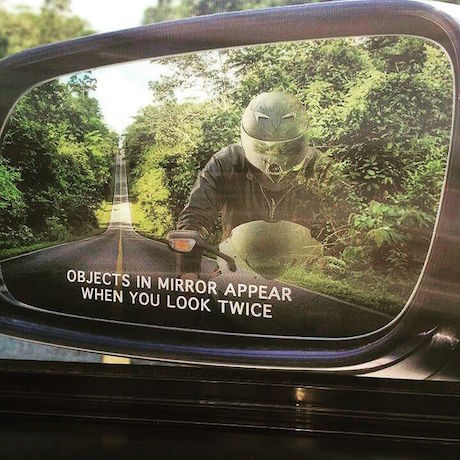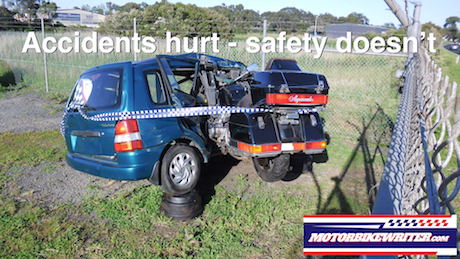SMIDSY (sorry, mate, I didn’t see you) collisions occur, not because motorists don’t look, but because they don’t look twice and when they do they don’t perceive how close we are.
That’s according to a Texas Tech University psychologist who says people think smaller objects are further away than they appear and conversely bigger objects are closer.
Researcher Pat DeLucia reached her finding by testing people in computer simulations.
She studied participants who viewed two approaching objects simultaneously – one large and one small. The viewer had to nominate which would reach them first.
Her study, “Current Directions in Psychological Science”, indicates that an object’s size affects distance perception, causing drivers to miscalculate riders’ distance and speed.
“People generally picked that simpler heuristic: Larger is closer,” says DeLucia.
Unfortunately, motorcycles are the smallest vehicles on the roads, yet are usually the fastest accelerating.
So drivers think we are going to arrive much later than we actually do.
It’s a lethal combination that could be the cause of up to three out of every four motorcycle collisions.
 Ok, so what do we do about it?
Ok, so what do we do about it?
- Having headlights on may make you more visible in some circumstances, but it doesn’t make a difference to the size of your bike.
- Position on the road is important. You need to ride in the wheel track closer to the centre line as this means you are visible sooner to oncoming traffic or vehicles turning across your path. It also gives you a buffer from vehicles suddenly emerging from a roadside parking bay.
- Weaving from one wheel track to the other also draws attention. It may look erratic and as though you have lost control, but it attracts much-needed attention.
- Never assume a driver has seen you.
- Assume they haven’t seen you and prepare an exit route in case they drive out in front of you or merge into your lane.
- Don’t ride in a vehicle’s blind spot.
- Give yourself a buffer zone from other vehicles.
- Slow down and get ready to take evasive action if you see a vehicle at an intersection.
- Wait until you see the whites of their eyes before accelerating. And even then, prepare for them to make a sudden move.
- If so, it is best to think about changing course behind the car, rather than in front of it. The normal reaction is to weave away from the direction that the threat is coming. However, that leads you into the direction the threat is heading, so you may still collide.
- If you don’t see the whites of their eyes, then it might be time to give a polite toot on the horn to alert them.
Riders tend to think SMIDSY collisions occur because motorists don’t care about motorcyclists.
That’s not necessarily true. Even if they don’t care about us as people, they still care about getting their car damaged.
Consequently, several car manufacturers are working on various blind-spot alerts that specifically recognise motorcycles. They even include an alert that taps a driver on the shoulder if they move into a lane occupied by a motorcycle.
Maybe they should also include wing mirrors with “look twice” messages like those in the photo at the top of this article.
You can read about those technologies, tips on being more visible and other SMIDSY collisions in the articles listed below.



 Ok, so what do we do about it?
Ok, so what do we do about it?